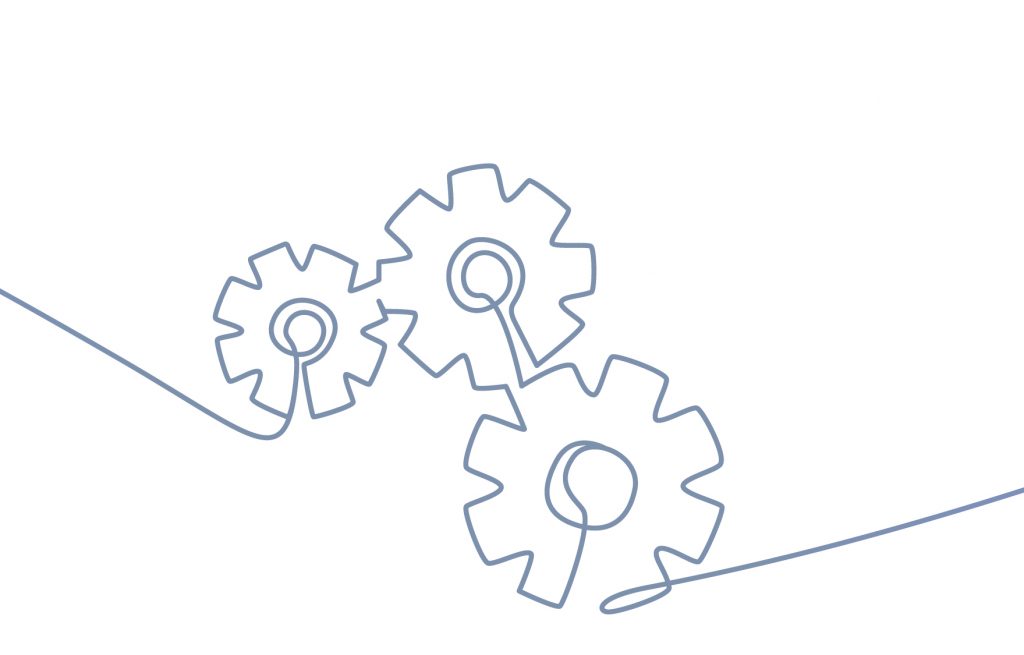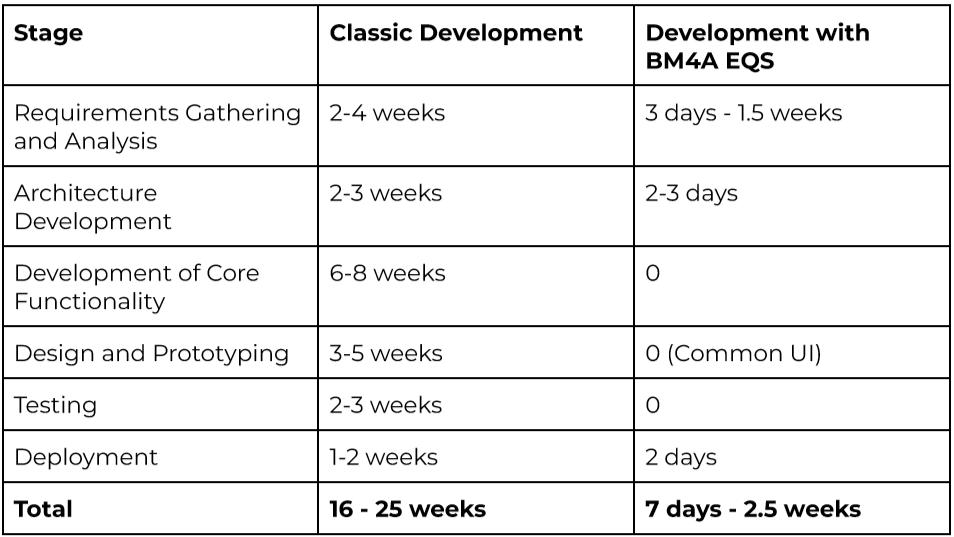Modular vs. Scratch Enterprise Application Development: Which is Faster for Corporate Applications?
Corporate web applications play a crucial role in how companies operate. They help automate processes, improve communication between departments, and control overall business. However, creating these applications from scratch can be time-consuming and resource-intensive.
To address this challenge, many companies are looking for faster and more budget-friendly ways to develop these apps. One option is to use ready-made modular solutions, such as BM4A Enterprise QuickStart (EQS).
Below, we’ll compare the traditional enterprise application development (from the ground up) with a ready-made technique, as well as demonstrate how the latter can speed up project timelines and lower costs without compromising on quality or functionality.
Typical Problems of Ready-Made Enterprise Application Software
It’s worth noting that while there are many ready-made solutions available on the market, such as ERP and CRM systems, they often don’t fully meet specific business needs.
Some key issues with using such standard enterprise application software include:
Too many features:
Many off-the-shelf solutions come with features your business doesn’t need, making the system harder to use and increasing expenses.
No ownership:
Cloud-based solutions are used as a service, meaning you don’t own the system and have no control and ability to customize it.
Limited customization and scalability:
Standard solutions often have restrictions, which makes it hard to tweak them to your unique business processes.
Mismatch with current processes:
Market solutions may not fit your company’s specific needs, forcing you to change your processes to match the system, which isn’t always effective.
When standard solutions do not meet your requirements, there are two main tactics to consider:
Development of a corporate web application from scratch:
This approach offers complete control over the process and functionality, but it requires significant time and financial investment.
Development with basic versions or modular solutions:
This approach is faster and more flexible, as it gives you a solid foundation to build on. You start with a ready-made solution, such as BM4A EQS, which already includes key features like authentication, CRUD editor, dashboards, document generation, file management, menus, query tools, and more.
Classic Development from Scratch
Building a corporate web app from scratch takes a lot of time and effort at every stage. From gathering requirements to launching the app, each step needs careful planning and work.
While this method gives you full control, it can lead to delays and higher costs because everything has to be built from zero. Here’s a simple breakdown of the key steps in traditional development.
1
Requirements Gathering and Analysis
This is a long process that involves thoroughly analyzing your business needs, designing all the necessary features from scratch, and setting up a clear structure. During this phase, you may encounter several issues, such as teams not being on the same page and the need to go through multiple approval steps.
2
Architecture Development
Building the architecture from scratch takes a lot of time because you have to think about many different things. You need to ensure strong security, design how different parts of the system will work together, plan for future growth, and make sure the application is stable and runs well.
3
Development of Core Functionality
Every system needs a solid foundation, which includes things like user authentication, authorization, data management (creating, reading, updating, and deleting data), and generating documents and files. Building all of this from the ground up takes a lot of work and effort.
4
UX/UI Design and Prototyping
The design must be customized for each business case, meaning it should meet the specific needs and preferences of the company. This involves understanding who will use the application and how users will interact with it. Because of this, the design process often takes time and goes through several rounds of revisions.
5
Testing and Debugging
Verifying new features and fixing bugs is no less time-consuming and demanding task. First, developers create a test plan that outlines what needs to be checked. Next, each feature must be thoroughly examined to ensure it works properly. This includes functional testing, user acceptance testing, and other checks.
6
Deployment
Enterprise application integration and deployment in standard development usually takes a lot of time to select and organize the right hardware and software.. On top of that, developers must test the app to ensure it works well for many users and in different situations, which adds to the overall time and efforts.
Development Using Ready-Made Modular Solutions (BM4A EQS)
Ready-made modular solutions, such as BM4A EQS, make development faster and easier by providing essential features and established structures right from the start.
This means companies can spend less time on complicated processes and more time focusing on what really matters.
Here’s a breakdown of how each phase benefits from using these modular solutions:
1
Requirements Gathering and Analysis
Essential core functions, such as authentication, authorization, CRUD editor, dashboards, document generator, file manager, and more are already built-in, which shortens the analysis phase since most of the core features are pre-set.
You don’t need to define every requirement and use case in detail. Having a general understanding of the business process is enough, and you can fine-tune things as development progresses through an iterative approach.
Win: Savings on analysis and planning of core modules.
2
Architecture Development
Using a ready-made product with an already built architecture significantly reduces time. It employs proven and widely known technologies, and your product is not a place for experiments.
Win: No need to spend time developing architecture and selecting technologies from scratch.
3
Development of Core Functionality
Solutions like BM4A EQS consist of modules that form the basis and core functionality of the product. All modules are tested and ready for use.
Thus, BM4A EQS represents a ready-to-apply base with the necessary features demanded in all corporate solutions, such as authentication/authorization, CRUD editor, dashboards, document generator, file manager, menu, query tool, common UI, and more.
Win: Savings of 1,500-2,000 development hours.
4
UX/UI Design and Prototyping
Ready-made components and templates can be quickly adapted to customer needs. In 90% of cases, design is secondary and low-priority in enterprise applications for business compared to functionality and implementation speed.
Specific UI/UX is only needed in key areas of the application and only as a way to improve usability. This can be done after launching the MVP based on real user experience of the application by your employees.
Win: Much reduction in time spent on design and interface development.
5
Testing and Debugging
Built-in modules are already tested and debugged, allowing for reduced testing time.
Win: Less time spent on testing standard functionality.
6
Deployment
Using cloud solutions like DigitalOcean allows for quick application deployment, minimizing time spent on infrastructure setup.
Win: Fast deployment and ease of management.

Comparative Analysis
Now, let’s explore the differences between modular enterprise application development and traditional development from scratch. We’ll focus on time, cost, and flexibility to prove how BM4A EQS can help speed up the development process, lower costs, and offer more flexibility to meet changing business needs.

Conclusion
Using modular solutions like BM4A Enterprise QuickStart (EQS) can greatly speed up the development of enterprise business applications, especially in the initial stages.
This approach lets companies concentrate on their specific business needs without wasting time creating basic features from scratch. As a result, they can roll out the product faster, save money, and enhance quality.
It’s essential to understand that, nonetheless, choosing between traditional development and ready-made modular solutions heavily depends on time limits, budget, business needs, and technical resources.
However, comparing both methods proves that modular solutions like BM4A EQS have clear benefits for optimizing the development of corporate web applications, reducing risks, and cutting costs.
Overall, using ready-made solutions like BM4A EQS is a more effective and affordable way for businesses to quickly get results while focusing on the most important parts of daily operations.
Let’s Connect: Reach out to Us Today!
Ready to make the most with our web application development services? Contact us now to kickstart your project discussions or join us for a live product demonstration.